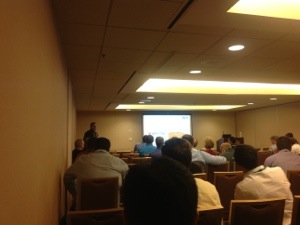 The promise of harvesting energy for wireless devices attracted me to this Emerson Exchange workshop. The abstract:
The promise of harvesting energy for wireless devices attracted me to this Emerson Exchange workshop. The abstract:
This presentation will highlight how vibration energy harvester (VEH) can be utilized as the primary power source for traditional “battery only” powered Emerson wireless transmitters used for process monitoring within a multitude of industrial environments.
All aspects of construction, operation, integration, life-cycles, OEM and end-user benefits, usage, ROI, installation will be presented. Presentation will be supported by data from 2 Texas field trials (Oxea, TX. and 1 other)as well as responsible Emerson personnel supporting these trials.
Batteries can be considered a finite energy source. Energy harvesting technologies are potentially infinite. There are also costs over time as batteries are serviced over time to change them out.
With an energy harvester, the battery remains in case to handle the cases where the vibration sources are not present. Keith Abate of Perpetuum explained that they had modified the battery pack in smart wireless devices such as the Rosemount 3051S to be able to pass the power from the harvester to the transmitter electronics.
He described a calculation based on a 10 year time horizon to consider the initial cost of the harvester and modified battery pack plus the maintenance cost of a few battery changes over the years to show the economic case for the VEH approach. The incremental cost addition for the harvesting solution is basically offset by the cost of avoiding a single battery change.
The harvest works by finding the resonance frequency of the vibration to generate the power. The vibration source must have frequencies that don’t change over time. For motors, 60Hz or 50Hz based on the supplied power provide a constant frequency.
At the Oxea field trial, the energy harvesting transmitters have been running for nearly one year. They can tell when the source of the vibration, such as close by motors go offline. The diagnostics show the switchover from vibration to battery source.
At the Firestone Polymer field trial, Emerson’s Tim Bonnin described the installation. One benefit was the ability to move to faster update rates since they did not have to worry about battery power drain.
Here at the Emerson Exchange, production version of the energy harvester system was announced. Beta units were used for these field trials. It’s important to understand that this VEH approach supplements the battery, since the vibration source must be present. When it’s not, the battery takes over operation. The harvesters feed a capacitive bank and diagnostics read these charge levels to determine when the battery needs to take over driving the wireless transmitter.
The presenters highlighted the need to look for potential applications to get experience with the technology.
